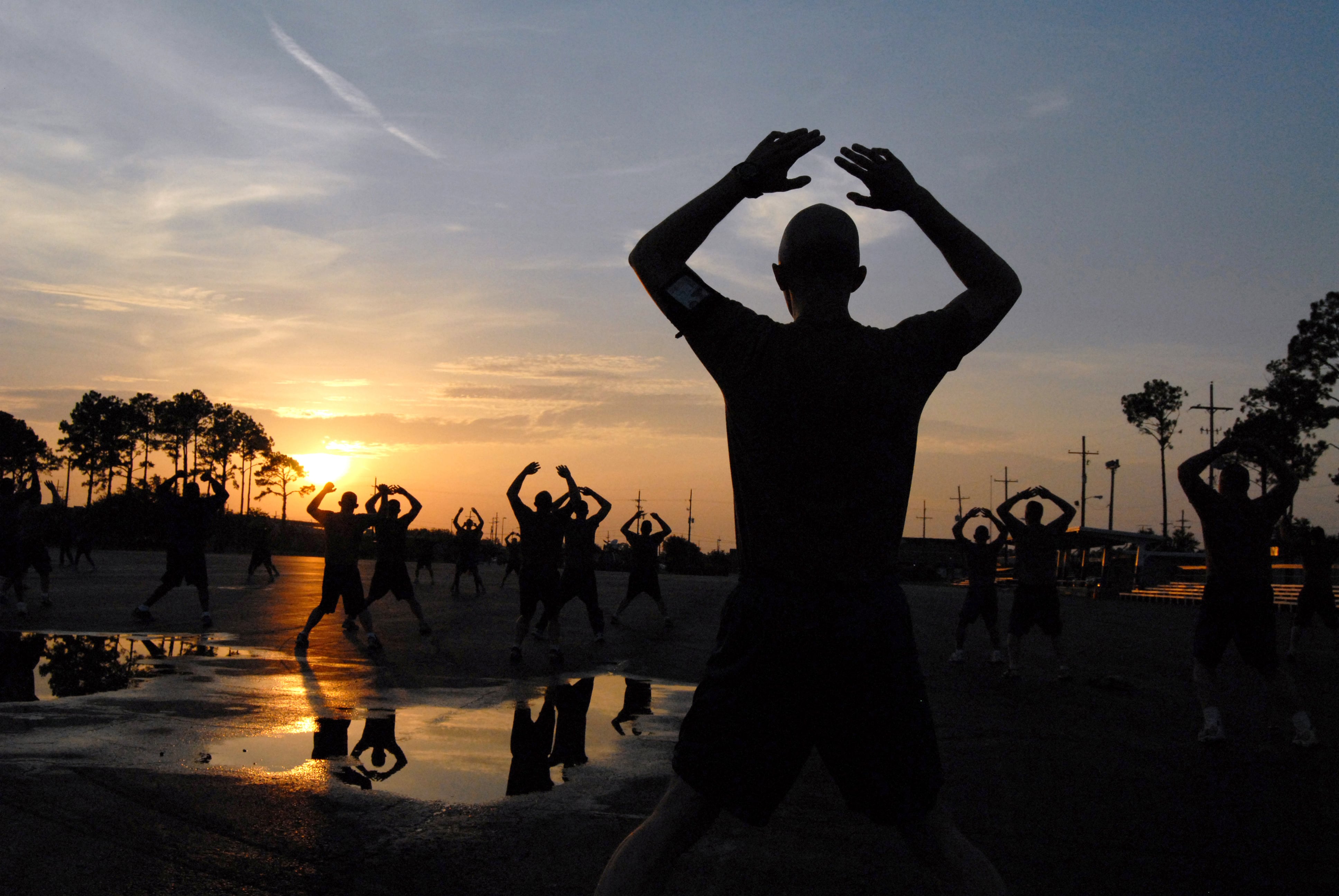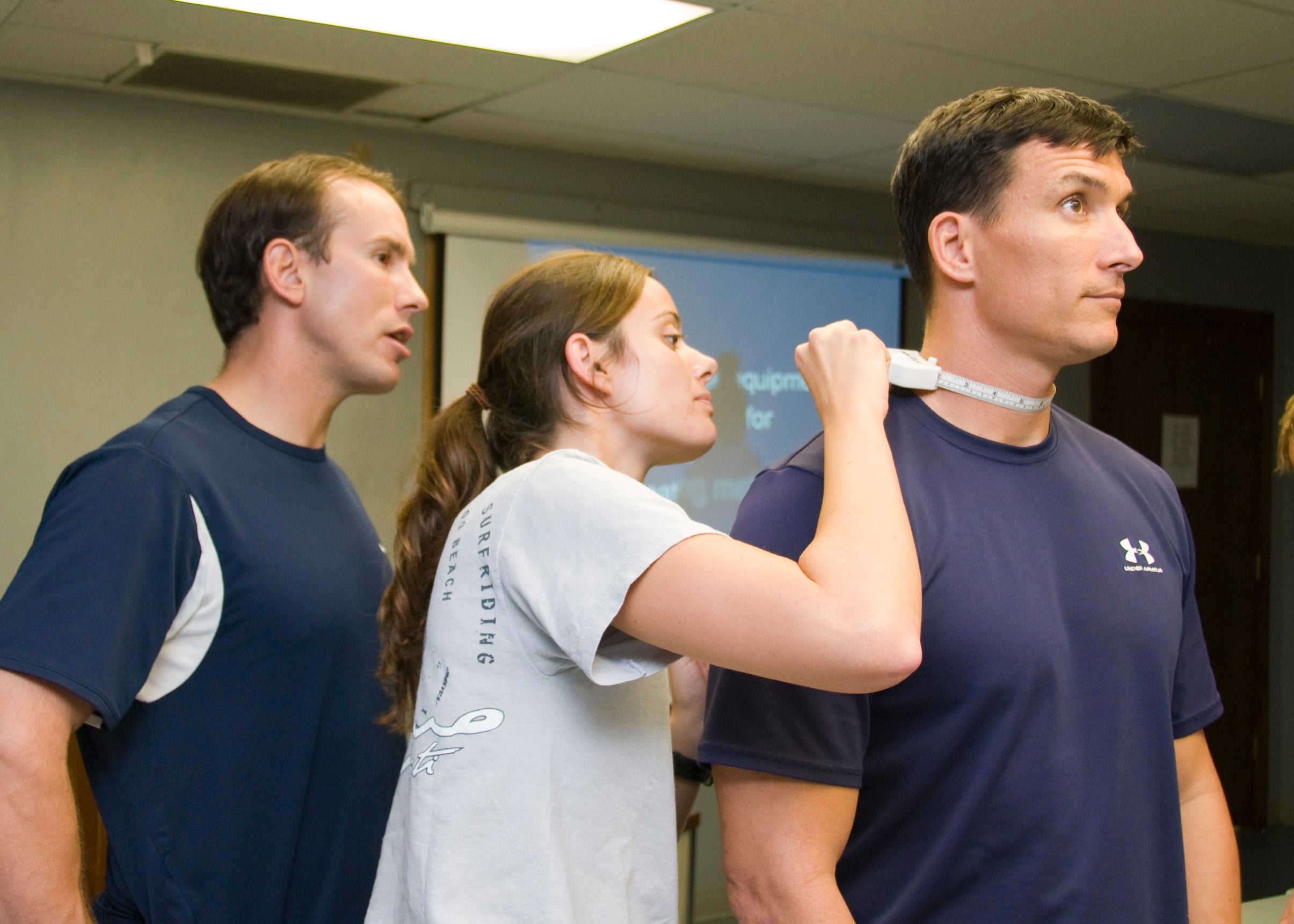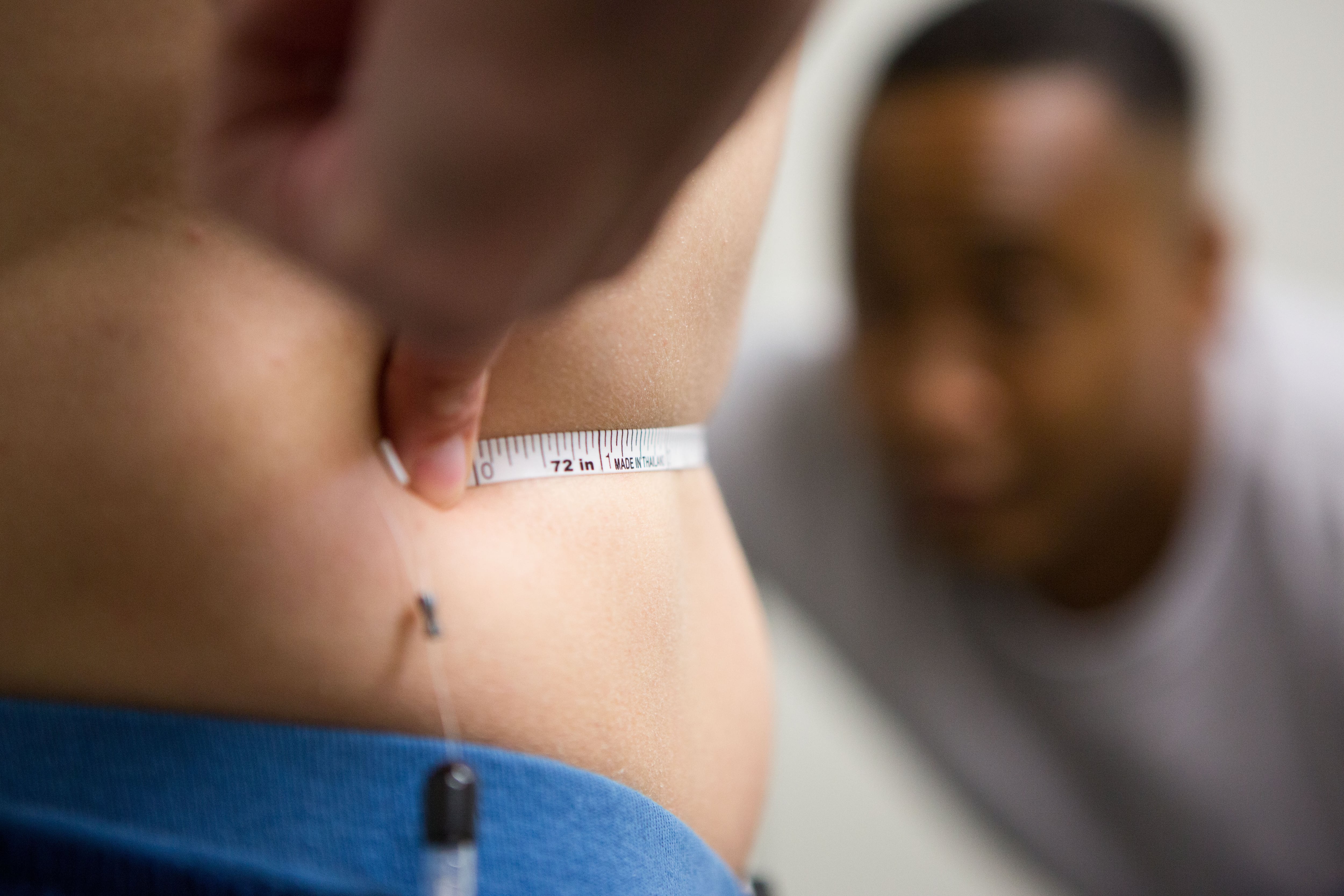The Navy's physical fitness assessment comes around twice a year like clockwork, and yet it continues to be the bane of many sailors' existences.
When the Navy's command fitness leaders came up with a list of nine recommendations three months ago to improve physical fitness assessments, their proposals rocketed through the ranks.
Three months ago, nine recommendations proposed by command fitness leaders rocketed through the ranks. Earlier this year, a list of nine recommendations from a recent command fitness leader summit spread like wildfire throughout the fleet.
They wanted mandatory tape tests, and random body composition assessments and the deep-sixing of "bad day" retests, among other extreme ideas. while doing away with "bad day" re-tests and alternative cardio options.
They got their say. Now it's your turn.
Do away with the body fat measurements, some sailors urged in response to a recent Navy Times call out for ideas that garnered hundreds of emails, and Facebook and online comments. Other popular suggestions: Make the physical readiness test reflect the shipboard environment; open gyms around the clock; and eliminate conflicts of interest for CFLs so everyone gets a fair rope-and-choke.
Some even urged the Navy to adopt Marine Corps PT standards. That would double the run to three miles, plus adding pullups or the flexed-arm hang, depending on gender.
The folks with at the Navy's Physical Readiness Program are constantly reviewing regulations and brainstorming ways to improve the twice-a-year physical fitness assessments, but sailors are also bursting with ideas about how to make things more efficient. Navy Times took the ideas to Bill Moore, PRP director, who commented on some of the ideas and said that the Navy wasis moving forward on two of them.
Moore said his team is focused on improving sailor fitness through a new push to get sailors to eat healthier, Though drastic changes aren't coming to Navy fitness any time soon, Moore said his team is focusing on spreading the word about their existing programs. That includes a big push for nutrition, with online meal and dietary guides, as well as a monthly newsletter.
"Fitness is more than just meeting BCA standards and passing the PRT," Moore said in an Oct. 15 phone interview. "The Navy uses a holistic approach to overall fitness and wellness via exercise, nutrition, weight control, stress management, mental health, tobacco cessation, prevention of alcohol abuse and health and wellness education to ensure readiness of the force."
put out a call to readers for their suggestions via Facebook and e-mail, then took them to Navy PRP director Bill Moore.
Here's What you said you wanted, and what the Navy says they can do about it:
Incentives for PT studs
Sailors have little incentive to ace the PFA other than their own pride. Many think it's past time for a change. As it stands, there can be little incentive for sailors to score more than the bare minimum on their PRT.
That includes those CFLs who, a few months ago, suggested that top scorers get special PT shirts, an idea that Navy officials said was not going fleet-wide. Earlier this year, a leaked list of suggestions from a recent CFL summit suggested special PT shirts for studs, but Navy officials denied that idea was going fleet-wide.
"We give our command triads the authority to reward their sailors as they see fit," Moore said.

Seabees gather in the early morning for battalion-level physical training. Commanding officers may integrate workout time into the work day, but not enough commands do it, sailors say.
Photo Credit: MC2 Erick S. Holmes/Navy
Those rewards could include recognition in the command's plan of the day or week, a convenient parking spot for someone who maxes out the test or even special liberty.
Others suggested another reward with long-term repercussions: Advancement points. The Navy already gives sailors points for college degrees, awards, or individual augmentation duty. Why not for acing the fitness test?
"A 'sat' would afford no points, and good, excellent, outstanding and max would afford five, 10, 15 and 20 points, respectively," Mike Saunders wrote. "We could even deduct points for failures to keep the non-performers from advancing."
Better CFLs
One of sailors' top complaints is that the PFA is a rigged system: If you're tight with the command fitness leader, they said, you're golden.
"Very rarely have I seen a command properly administer a PFA/PRT," wrote Master at Arms 1st Class (SW/EWX) Lauren Bryant, one of many who believe that favoritism and command conflicts of interest can mar the reporting process. "My recommendation would be to hire an outside fitness company to administer the PFA/PRT."
Another approach could be to have sailors from another command administer the PFA.
Officials say that the great majority of PFAs are fair, and they are taking measures to improve the standards and professionalism of the CFLs who run them.Though CFL is a voluntary collateral duty. Sailors chosen for the position must that requires sailors chosen for it to sailors assigned to the position are required to complete a five-day training course within three months of taking it on.
"They are well-trained to conduct the official Navy PFA and are required to maintain certification standards," Moore said.
However, in order to further legitimize the position, Moore said the PRP office was recommending the Navy approve CFL the Navy has approved CFL for its own enlisted classification, set to take effect in a forthcoming fitness naval message. which will take effect in the next fitness NAVADMIN.
That extra designation means you can't become a CFL until after you've taken the course.
"They will be added to a tracking database, which will show who's been certified, when, and where they are," Moore said in a Oct. 15 phone interview.
Still, several readers were concerned that in-house CFLs are counting fake push-ups or holding the measuring tape tighter for their buddies.
"I learned that as long as you look like you're in shape, you out ranked the CFLs, or you are were drinking buddies with them that you were fine, but if you had a gut and struggled your every move was scrutinized." Hospital Corpsman 2nd Class (SW) Derek Clarno wrote.
Job-relevant tests
Many sailors are askeding themselves why a mile-and-a-half run holds so much power over their jobs. Rather than the run, pushups and situps, they said, shouldn't a sailor's PT test reflect things they do in their jobs?
"When was the last time a ship was 1.5 miles long?" wrote K. Scott Landers on Facebook. "Make the test more realistic. Have an obstacle course and include body drag and other true-life obstacles a lot, like some police PRT courses, and set time limits for completion."
While there are several job-specific PT tests in the Navy, particularly in expeditionary units like special warfare and the riverines, the forcefleet-wide PRT is not designed to evaluate a sailor's job fitness — and that isn't going to change, Moore said.

A sailor performs lunges with a bumper plate in the hangar bay of the aircraft carrier USS Harry S. Truman (CVN 75).
Photo Credit: MCSN Karl Anderson/Navy
"We have the current PRT in place because it is a test that can be administered across the entire Navy," he said. "It is designed to test for a baseline of sailors' fitness levels."
That's to say, the 1.5-mile run evaluates sailors' basic heart and lung function in general, regardless of job description. Despite The logistics of a ship-centric test aside, Moore said, a physical assessment like that would go beyond what the PRT is trying to measure.
"Given that we are a sea-going expeditionary service, we've determined this method to be the best for the Navy, given our operational requirements," he said.
Rethinking rope-and-choke
More than the physical portion of the assessment, many sailors are tripped up when it comes to passing height and weight standards.
Many argue say the height-weight chart is outdated, while others say that the tape test for those over the height-weight limits is too subjective and doesn't take into account sailors' diverse builds. Officials acknowledge those concerns, but say that these are still the easiest and most accurate ways to measure body fat at bases around the globe.
"The current method used for the body composition assessment has been carefully evaluated against other methods and for applicability to service members, and given that we are a sea-going expeditionary service, it is logistically the most feasible way to accurately measure," Moore said.

A fitness program coordinator observes a sailor perform a body composition assessment as part of the Command Fitness Leader course. Navy leaders are taking measures to improve the standards and professionalism of the CFLs who run physical fitness assessments.
Photo Credit: MC2 Paul Honnick/Navy
However, many think that their thicker waists and smaller necks shouldn't determine whether they're too out of shape to serve.
Calipers, which pinch skin folds to calculate body fat, are a commonly suggested alternative to tape. So is water displacement measured in a dunk tank. It turns out, though, that they aren't necessarily the most accurate either.
According to the Centers for Disease Control and Prevention, it's difficult to standardize machines or observers, so measurements can still vary greatly.
An aviation electronics technician 1st class, who requested his name not be used, suggested only taping waists, the way it's done in the Air Force.
"Anything above 40 inches on males and 35 or 36 inches on females is failing," he said. "That's a solid idea."
The Air Force recently revamped its body composition assessment, taking only waist measurements and putting in place a 39-inch max for men and a 35.5-inch max for women, regardless of age.
Under current standards, a man with a 40-inch waist and a 19.5-inch neck would still fall within an acceptable body fat percentage, but Moore emphasized that a pass on the Navy BCA doesn't indicate ideal health.
"Any man with a waist circumference of 40 inches or greater and any woman with a waist circumference of 36 inches or greater is at high risk for heart disease, diabetes and sudden death," he said.
According to the National Institutes of Health, men with waists 35 to 39 inches or women with waists 32 to 35 inches are at moderate risk for heart disease and diabetes, regardless of whether they pass their PFA.
Canning the BCA
So if the PRT measures fitness and a sailor passes it, many wondered, then why should he have to go through the body composition assessment at all?
Some go as far as to say the Navy should do away with BCA altogether, or let sailors who get an "excellent" score excellents on their PRT skip weigh-ins.
"The BCA methods are outdated and it's very evident," Legalman 2nd Class (SW/AW) Renae Palache wrote. "I brought up the topic during the CFL certification course I attended and was quickly shut down by one of the instructors with, 'It is the most accurate, affordable way.' "

PT Testing at Lackland Air Force Base.
Photo Credit: Colin Kelly/Staff
Rather than reform the standard, some sailors suggested letting top scorers skip the BCA or take body fat percentage out of the equation altogether.
"Members should be graded on their military bearing on the command level by their appearance in the uniform and their score on the PRT," suggested an aviation electronics technician 1st class assigned to Naval Air Station Whidbey Island, Washington, who requested his name not be published.
AT2 (AW) Jacob Carpenter agreed.
"If sailors score high on their PFA, they should be given a pass on the body composition portion of the PFA process, provided they are not grossly overweight and do not detract from appearance in uniform," Carpenter said.
Mandatory command PT
Navy instruction allows commanding officers to integrate workout time into the work day, but not enough commands do it, sailors say. It falls victim to is often scarce in reality — at the whim of busy schedules or, and for fleet sailors, deployments. due to busy schedules and deployments, most fleet commands find operational requirements, many don't make it a priority.
"The biggest problem I see is that once you leave boot camp, you are supposed to stay fit on your own, but I don't really think they prepare anyone for how to do that," Monica Moore wrote. "Maybe if the Navy wants everyone to stay physically fit then they need to continue to have mandatory PT every day like they do in boot camp.
Moore said the "vast majority" of Navy commands integrate time for PT into the work day, but some readers said it isn't wide-spread enough.
"Command PT is the only way you will ensure everyone who is not on a medical waiver is staying fit," wrote Dawn Gee-Wessel. "Giving two-hour lunches in hopes that someone will PT is just not enough."
Beyond that, group work-outs set a good example, she said.
"Command PTs also build team-building skills and camaraderie. It ensures people are fit, from the lowest ranks to the highest, and lower enlisted see leaders doing it, too," she said.
Another reader wrote that COs shouldn't take the instruction as an excuse to keep sailors at work longer.
"How about having commands actually follow current instruction, like having command PT during normal working hours, which are not to be extended to fit PT in?" Nick Thomsen wrote. "Almost every command thinks it's OK to make everyone show up super early in the morning before work to PT."
24-hour base gyms
Sailors work odd hours all throughout the fleet work odd hours, and sometimes that means the inspiration to work out hits at 2 a.m., when the options for a good workout are few to none.
One sailorFacebook commenter suggested keeping base gyms open 24-hours — an idea that Moore favors and has brought up with which Bill Moore said he has brought up to Navy Installations Command before.
"Given the fiscal environment, expanding services or building new facilities can be challenging, but we continue to share sailor feedback with our colleagues at CNIC nevertheless," Moore said. "To the credit and Where possible, CNIC and local base leadership have prioritized revamping, expanding or renovating gym, workout and training facilities across the fleet."
It's for this reason, he said, that his office developed the Navy Operational Fitness and Fueling System. You can learn the workouts from a trainer on base or carry them around in your pocket with three available Android and iPhone apps, with different workouts preloaded.
There are also kits that sailors can check out from MWR to do the workouts at home. They include the sandbags and straps the program is built upon, minimizing the amount of space at home that sailors need to exercise.
Never gonna happen
Make CFL a rating
Adopt Marine Corps PT and physical standards
Four PFAs a year
Heart rate, cholesterol and blood pressure measurements instead of body fat
Equal minimum scores across genders and ages
Take measurements over multiple days and average them
Add pullups to PRT
Extend boot camp to three months, third month for physical fitness training
Random BCA tests
No more "bad day" re-tests
Excellent scores get to skip their next test
Meghann Myers is the Pentagon bureau chief at Military Times. She covers operations, policy, personnel, leadership and other issues affecting service members.




